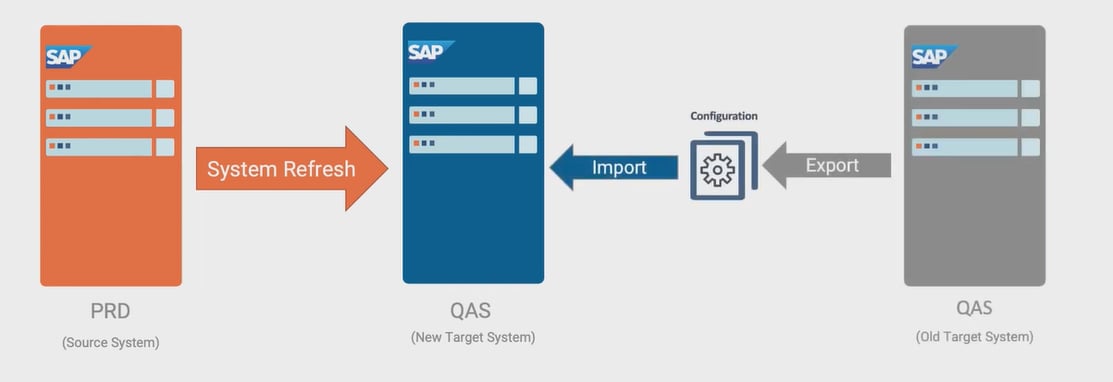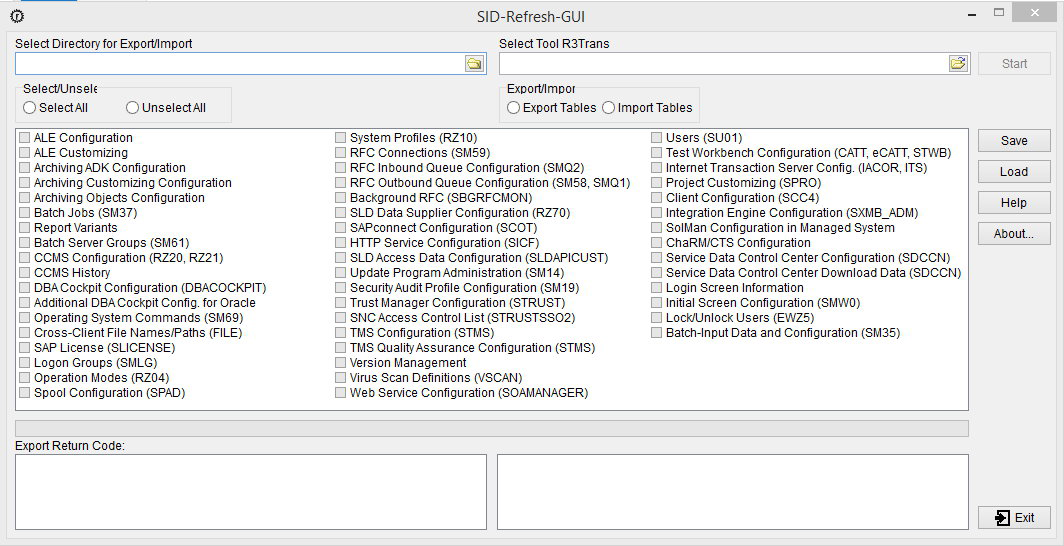With contributions from Paulina Jaramillo
In a few words, system refresh is simply copying one SAP system to another when the target SAP system already exists. This is similar to a system copy, where the process involves copying the production system (PRD) to the quality assurance (QA or QAS) and/or development (DEV) systems. Its main purpose is to provide updated data for testing purposes, as well as to facilitate major system upgrades. This is typically done to ensure that non-production systems (i.e., Testing, DEV, and QA environments) are aligned with the production system in terms of data and configuration.
One example would be copying the source PRD SAP system to a QAS SAP system. SAP has tools to back up your source system, database clone, or with R3load for ABAP and Jload for JAVA. The exact steps and complexity of a SAP system refresh can vary depending on the specific SAP landscape and the organization's requirements, but here is a general overview of the traditional process.
SAP recommends organizations to perform this process every 3 months. Regular system refreshes are recommended to ensure that the overall data remains consistent and accurate. It can even help identify and resolve data integrity issues that may have arisen due to system usage.
 Figure 1: System Refresh Manual Process
Figure 1: System Refresh Manual Process
What’s involved in a manual System Refresh process?
- Planning and Preparation: This involves identifying the involved systems, such as the source (the production system) and the non-production target (quality assurance, development), determining the scope of the refresh, and which data and configurations need to be copied from the production system to the target system, and ensuring that the involved systems are backed up to minimize the risk of data loss
-
Data Export (Production System): Export the relevant data from the production system. This usually includes data from databases, file systems, and SAP application data.
-
Data Transfer to Target System: Transfer the exported data to the target system. This usually involves copying databases, files, and SAP-specific data directories.
-
Configuration Transfer: Copy the configuration settings and parameters from the production system to the target system. This usually includes SAP profiles, instance profiles, and any custom configurations.
-
Perform System Refresh Activities in Target System: These include restoring the database to match the state of the production system at the time of the export and applying necessary patches or support packages
-
Perform Post-Refresh Activities: Such as validating the data and configuration in the target system to ensure that they match the production system accurately, and performing tests (if necessary) to ensure that the refreshed system behaves as expected
Navigating the Roadblocks
A traditional system refresh is usually complex, costly, and takes away from the time of skilled resources. However, we can list several, more specific pain points in a traditional system refresh.
-
BDLS transaction takes a long time to convert logical system names.
-
Target systems will have the entire dataset, which includes the transaction history kept in the system
-
There are many projects running and customers struggle to find the right timeframe to complete them.
-
A Typical SAP System Refresh requires an SAP Netweaver/Basis Administrator, Project Manager, Storage Administrator, Database Administrator, and OS system Programmer.
-
Installing, maintaining database libraries, cloning databases, and performing the SAP system refresh of the database can take days to weeks.
-
If a refresh in the middle of a project gets disrupted, the refresh may not be performed at all.
-
Each environment needs to be created, and the new SAP system should be installed and customized before the migration.
-
The system administrator must manually configure the network, database connection, and application server instances
-
Configuring a database is complex, and each instance may have as many as 80,000 tables.
-
There are many steps involved and human work is error-prone
Smooth and flawless operations of systems are the key to keeping business processes on track. This requires a combined effort of all database admins, programmers, and SAP SMEs. As the complexity of computing environments increases, SAP solution experts are challenged to deliver cost-effective and timely results.
Automation with SID-Refresh™ to the Rescue
 Figure 2: IT-Conductor SID-Refresh Tool
Figure 2: IT-Conductor SID-Refresh Tool
The IT-Conductor SID-Refresh tool offers a simplified approach to the SAP system refresh process and streamlines numerous administrative tasks into one, automated, end-to-end workflow, standardizes and speeds up the time to complete the refresh from days to hours, reducing the risk of human error.
In a few words, the SID-Refresh tool summarizes the system refresh process in the following 3 steps
-
Export system configuration, where the configuration data of the “old” system will be exported as a table using R3Trans
-
Perform System Copy: Here, we'll copy the database of the PRD system into the QA or DEV system, then, the copied system will be renamed into the same SID, hostname, and installation number as the previous QA/DEV system. Finally, we’ll clean up the contents of the table that contain information about the source system
-
Import System Configuration, where the configuration data from the “new” system, stored from the file system is imported into the new QA system using R3Trans.
If the system does not exist and you need to build a new system on the same operating system and database as the source system, this is a homogeneous system copy. If the operating system and/or database of the target system is different than the source system, it is known as a migration or heterogeneous system copy.
Related blog post:
SAP Basis Automation with SID-Refresh Supports S/4HANA, ECC CRM BW
Exploring the Benefits
Automating manual tasks such as system refresh typically raises productivity, increases efficiency, and reduces the costs and risk of human errors. The IT-Conductor SID-Refresh Tool brings the following benefits
-
Standardizes and speeds up the time to complete the refresh from days to hours
-
SAP Basis teams can spend less time waiting for long-running tasks to be completed and can spend more time doing productive work that is useful to your business.
-
Reduces the complexity involved in creating, managing, and copying SAP database environments.
-
The solution can be used to configure and fully automate the standard tasks required to deploy an SAP database server environment. Custom orchestration can be tied to end-to-end system copy steps before and after the Post-Copy Automation (PCA) tasks.
-
Free up the time from repetitive and boring tasks so SMEs can perform higher-level work.
-
Automation simplifies the SAP System Refresh process and streamlines administrative tasks into one, automated, workflow
Want to learn more about SID-Refresh with IT-Conductor? Follow our YouTube channel or visit the SID-Refresh User Documentation for more details.
Testimonials
"With SID-Refresh we save a lot of time, exporting customizing settings before an SAP System database refresh, and even more, when restoring them, after the copy: the tool rebuilds the selected customizing settings in a safe way and prevents possible mistakes coming from manual changes."
- Dino Dose, Team Manager @ BGP Technology
"We used SID-Refresh several times. It amazes me with its simplicity and minimum time spent on starting up the system during copying. The most pleasant that the program is adapted for Linux systems!"
- Yuliia Bazyliuk, Head Engineer @ The National Bank of Ukraine
"I'm an independent Basis Consultant who used SID-Refresh on a BW System Refresh for a client. I'm fascinated by how well it works. It is truly a high-quality solution that deserves to be known around the world!"
- Eduardo Andrés Lallo, Sap Basis Administrator (Sap HANA Certified Technology Consultant)


